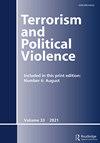Dams, Terrorism, and Water Nationalism’s Response to Globalization and Development: The Case of South Asia
IF 2.1
2区 社会学
Q1 INTERNATIONAL RELATIONS
引用次数: 3
Abstract
ABSTRACT Building on a global research sweep of terrorist organizations’ (as well as other non-state actors such as separatist and insurgent groups) use of fresh water as a target, weapon, or source of control, this paper analyzes attacks on major water projects (specifically dams and other related infrastructure) in South Asia—the region identified to have had the largest number of recorded water-related violent incidents. Focusing on India, Pakistan, and Afghanistan, and the post 9/11 period through 2019, the paper explores how large water infrastructures (and their environs) have become hot spots for violence between states that use water development projects to consolidate power, garner local loyalty, and create a national narrative and non-state actors who attempt to target these same projects to assert indigenous self-determination, subvert state power, or challenge state authority through terrorist means. Since fresh water is shared across borders, dam projects can become entangled in regional political disputes further exacerbating violent conflict between state and non-state actors. Given its impacts on water resources, climate change may act as a “threat multiplier” by enhancing local grievances, providing both government and terrorist groups additional incentives for exploitation, and further contributing to instability. The analysis provided here borrows from and contributes to the fields of development, environment and security, and terrorism studies.水坝、恐怖主义和水民族主义对全球化和发展的回应——以南亚为例
摘要基于对恐怖组织(以及分离主义和叛乱组织等其他非国家行为者)将淡水作为目标、武器或控制来源的全球研究,本文分析了南亚主要水利项目(特别是大坝和其他相关基础设施)遭受的袭击。南亚是有记录以来发生与水有关的暴力事件最多的地区。本文聚焦于印度、巴基斯坦和阿富汗,以及截至2019年的后9/11时期,探讨了大型水利基础设施(及其周边地区)如何成为国家之间暴力的热点,这些国家利用水利发展项目巩固权力,赢得地方忠诚度,并创造一种国家叙事和非国家行为者,他们试图以这些项目为目标,维护土著自决权、颠覆国家政权或通过恐怖手段挑战国家权威。由于淡水是跨境共享的,大坝项目可能会卷入地区政治争端,进一步加剧国家和非国家行为者之间的暴力冲突。鉴于气候变化对水资源的影响,它可能会加剧当地的不满情绪,为政府和恐怖组织的开采提供额外的激励,并进一步加剧不稳定,从而成为“威胁倍增器”。这里提供的分析借鉴并有助于发展、环境与安全以及恐怖主义研究领域。
本文章由计算机程序翻译,如有差异,请以英文原文为准。
求助全文
约1分钟内获得全文
求助全文
来源期刊

Terrorism and Political Violence
Multiple-
CiteScore
5.60
自引率
8.30%
发文量
87
期刊介绍:
Terrorism and Political Violence advances scholarship on a broad range of issues associated with terrorism and political violence, including subjects such as: the political meaning of terrorist activity, violence by rebels and by states, the links between political violence and organized crime, protest, rebellion, revolution, the influence of social networks, and the impact on human rights. The journal draws upon many disciplines and theoretical perspectives as well as comparative approaches to provide some of the most groundbreaking work in a field that has hitherto lacked rigour. Terrorism and Political Violence features symposia and edited volumes to cover an important topic in depth. Subjects have included: terrorism and public policy; religion and violence; political parties and terrorism; technology and terrorism; and right-wing terrorism. The journal is essential reading for all academics, decision-makers, and security specialists concerned with understanding political violence.
 求助内容:
求助内容: 应助结果提醒方式:
应助结果提醒方式:


